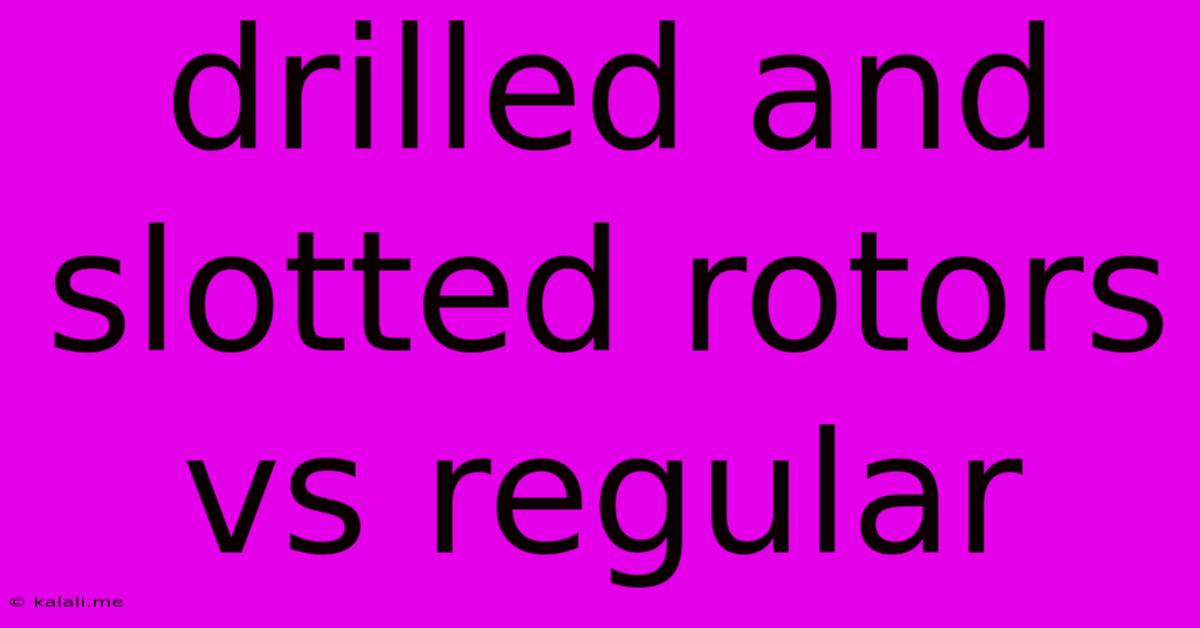Drilled And Slotted Rotors Vs Regular
Kalali
Jun 01, 2025 · 3 min read

Table of Contents
Drilled and Slotted Rotors vs. Regular: Which Brake Rotor is Right for You?
Choosing the right brake rotors for your vehicle can significantly impact braking performance, feel, and longevity. While standard rotors are a reliable and cost-effective option, many drivers explore drilled and slotted rotors, promising enhanced braking power and reduced brake fade. But are these performance upgrades worth the investment? This article will delve into the differences between drilled, slotted, and regular brake rotors, helping you make an informed decision.
What are the different types of brake rotors?
-
Regular Rotors: These are the standard, mass-produced brake rotors found on most vehicles. They are typically cast iron and feature a smooth, flat surface. They're known for their reliability, affordability, and relatively long lifespan.
-
Drilled Rotors: These rotors have precisely drilled holes throughout their surface. The holes are designed to improve brake cooling by allowing air to flow through the rotor, dissipating heat more effectively. This helps reduce brake fade, especially during demanding driving conditions like aggressive braking or track use.
-
Slotted Rotors: Instead of holes, slotted rotors feature slots cut into their surface. Similar to drilled rotors, these slots help to improve brake cooling and clear away gas and debris from the brake pad surface, improving braking consistency.
-
Drilled and Slotted Rotors: Combining the features of both drilled and slotted rotors aims to maximize the benefits of both designs. This offers the potential for superior cooling and improved brake performance.
How do Drilled and Slotted Rotors improve braking?
The primary benefits of drilled and slotted rotors lie in their enhanced cooling and cleaning capabilities.
Improved Cooling: The holes and slots provide channels for airflow, drawing cool air to the rotor's surface and expelling hot air. This reduces the rotor's operating temperature, preventing brake fade – a decrease in braking effectiveness due to overheating. This is particularly crucial during high-performance driving or extended periods of hard braking.
Enhanced Cleaning: The slots and holes help to clear away dust, debris, and gases from the brake pad contact surface. This improves the contact between the brake pads and the rotor, leading to more consistent braking performance. Less build-up means more effective braking power throughout the life of the brake pads.
Improved Bite: The grooves and holes created by drilling and slotting can provide a slightly more aggressive bite initially, particularly in wet conditions. However, this effect is often minor and shouldn't be considered a primary advantage.
Disadvantages of Drilled and Slotted Rotors
While offering performance enhancements, drilled and slotted rotors also have some drawbacks:
-
Higher Cost: Drilled and slotted rotors are generally more expensive than standard rotors due to their more complex manufacturing process.
-
Potential for Cracking: The holes in drilled rotors create stress points that can potentially lead to cracking under extreme stress, although modern manufacturing techniques mitigate this risk considerably. Proper installation and maintenance are key.
-
Increased Noise: Some drivers report increased brake noise, particularly during initial braking, with drilled and slotted rotors.
-
Reduced Rotor Life: While not always the case, the extra stress points and the surface area reduction might result in slightly reduced lifespan compared to standard rotors. This depends heavily on driving habits and conditions.
Which Rotor Type is Best for You?
The best type of brake rotor depends on your driving style and needs:
-
Daily Drivers: For everyday driving, standard rotors are usually sufficient. They offer a good balance of performance, reliability, and cost-effectiveness.
-
Performance Drivers: If you frequently drive aggressively, tow heavy loads, or participate in track days, drilled and slotted rotors could provide significant benefits by mitigating brake fade and improving overall braking performance.
-
Budget-Conscious Drivers: Standard rotors are the most economical option.
Ultimately, the decision comes down to your priorities. Weighing the enhanced performance of drilled and slotted rotors against their higher cost and potential drawbacks will help you determine the best choice for your vehicle and driving habits. Consulting with a qualified mechanic can also provide personalized advice.
Latest Posts
Latest Posts
-
How Do You Reply To How Do You Do
Jun 03, 2025
-
How To Cut Latex So It Doesnt Tear
Jun 03, 2025
-
Can You Convert A Gas Clothes Dryer To Electric
Jun 03, 2025
-
4 Cycle Engine Oil In Engine For 3 Years
Jun 03, 2025
-
How To Find A Gfci Outlet
Jun 03, 2025
Related Post
Thank you for visiting our website which covers about Drilled And Slotted Rotors Vs Regular . We hope the information provided has been useful to you. Feel free to contact us if you have any questions or need further assistance. See you next time and don't miss to bookmark.